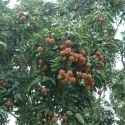24 Jan 2015
Nutrient management for sorghum in Chongqing
Sorghum is a key ingredient in liquor production. In recent years, the demand for liquor has increased considerably, and so the area planted to sorghum has increased. The aim of this experiment was to work out the best nutrient management guide for sorghum in Chongqing, China. The experiment consisted of ten treatments including four rates of N (0, 110, 220 and 330 kg N/ha), four rates of P(0, 60, 120, 180 kg P2O5/ha) and four rates of K (0, 65, 130, 195 kg K2O/ha) and was replicated three times. Nitrogen was used as urea (N 46%), P as SSP (P2O5 12 %) and K as KCl or MoP (K2O 60 %). All P, 40% of N and 50% of K were applied as basal fertilizers at seeding, and the rest of the N and K fertilizers were topdressed at elongation stage.
Results showed that sorghum yield significantly increased with an increase in the rates of N, P and K and reached the highest value of 7817 kg/ha at the set-optimal rates of 220-120-130 kg N-P2O5-K2O/ha. This implies that the set-optimal rates can be used in the region before any adjustment is made through future field experiments. Yield increase with nutrient application followed the order: N (18%) > P (12%) > K (9%). The agronomic efficiency of N fertilizer was highest at the set-optimal rate, while those for P and K decreased with an increase in fertilizer rates. The net income was the highest ($US 3418 /ha) for the set-optimal fertilizer rates, which was 26%, 24% or 10% higher than the treatment omitting N, P or K, respectively. The ratios of nutrient partitioning in grain to straw decreased with an increase in N and P rates, but remained relatively constant for K rates. This indicated strong K-absorption ability of sorghum even at high grain yields.




